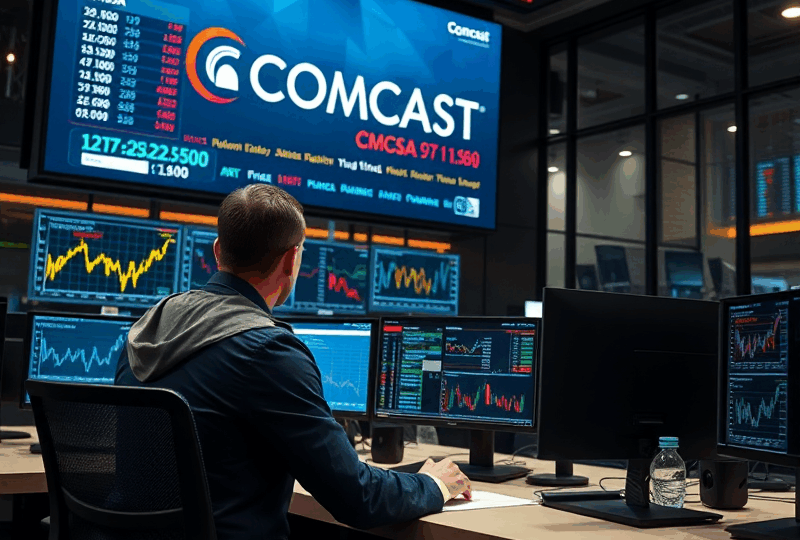
Comcast Stock Analysis: Is This Telecom & Media Giant Still Worth Investing In?

Overview: Comcast in 2025 and Beyond
Comcast Corporation (NASDAQ: CMCSA) remains one of the largest media and telecommunications companies in the United States. With operations spanning broadband, cable TV, streaming (Peacock), and NBCUniversal, its diversified portfolio has long attracted investors. However, as of 2025, the landscape has shifted significantly. Increased competition from streaming-only platforms, evolving consumer behavior, and regulatory scrutiny have all influenced Comcast’s trajectory. While its broadband segment continues to generate strong cash flow, the traditional cable TV model is under pressure. Investors must now evaluate Comcast not as a growth stock, but as a stable income-generating asset with moderate upside potential.
Financial Performance: Recent Trends and Key Metrics
According to Comcast’s Q1 2025 earnings report, total revenue reached $31.2 billion, a 1.8% increase year-over-year. Broadband services accounted for 41% of total revenue, while cable TV declined by 6.3%. Notably, Peacock reported a 14% subscriber growth, now totaling 38 million paid users. Operating cash flow stood at $9.7 billion, with a free cash flow of $3.1 billion, indicating strong liquidity.
Dividend yield currently sits at 3.1%, and Comcast has continued its share repurchase program, buying back $2.4 billion worth of shares in the past 12 months. These shareholder-friendly policies are attractive for income-focused investors. However, debt remains a concern. As of March 2025, Comcast holds $94 billion in long-term debt, though it maintains an investment-grade credit rating (BBB+ by S&P Global).
Source: Fidelity
Comparative Analysis: Comcast vs. Industry Peers
To better understand Comcast’s position, let’s compare it with key competitors like Charter Communications (CHTR) and Disney (DIS):
| Company | Market Cap (2025) | Dividend Yield | Streaming Subscribers | Debt-to-Equity Ratio |
|---|---|---|---|---|
| Comcast | $175B | 3.1% | 38M (Peacock) | 1.8 |
| Charter | $85B | 0% | N/A | 2.1 |
| Disney | $205B | 1.4% | 153M (Disney+) | 1.2 |
While Comcast offers a higher dividend than Disney and Charter, its streaming scale lags behind Disney+. Its broadband dominance gives it an edge over Disney, but Charter’s leaner model may appeal to investors seeking pure telecom exposure.
Expert Insight: What Analysts Are Saying
According to a recent analysis by Morningstar’s equity research team, Comcast is rated as “fairly valued” with a 3-star rating. Analyst Mike Hodel notes, “Comcast’s broadband moat remains intact, but growth is limited. The company’s ability to monetize content through Peacock and maintain broadband ARPU will determine long-term shareholder returns.”
Meanwhile, Bank of America’s 2025 telecom outlook suggests Comcast’s investment in fiber upgrades and AI-powered customer service could reduce churn and operational costs over the next three years. However, regulatory risks tied to net neutrality and antitrust scrutiny remain on the horizon.
Source: Morningstar, Bank of America
Scenario Analysis: Bull vs. Bear Case
Bull Case (2025–2027): Comcast leverages its broadband infrastructure to roll out 10G internet, boosting ARPU and reducing churn. Peacock gains market share through exclusive sports and news content. Free cash flow grows at 5% CAGR, supporting dividend hikes and buybacks.
Bear Case: Cord-cutting accelerates faster than broadband growth. Peacock fails to compete with Netflix and Disney+. Regulatory fines or breakup pressures emerge. Debt servicing becomes a concern if interest rates remain elevated.
Investors should weigh these scenarios against their risk tolerance and income needs.
My Perspective as a U.S.-Based Investor
As someone living in the U.S. and using Comcast’s Xfinity services, I’ve experienced both the reliability of their broadband and the frustration of rising prices. From an investor’s standpoint, I see Comcast as a solid income stock rather than a growth engine. I personally hold a small position in CMCSA in my Roth IRA for its dividend and stability, but I’m cautious about adding more until Peacock shows clearer profitability.
For long-term investors seeking steady income with moderate capital appreciation, Comcast can still be a viable option—especially if bought during market dips. However, it’s not a “set it and forget it” stock anymore. Active monitoring is essential.
Conclusion: Is Comcast Still Worth Investing In?
Comcast in 2025 is a different beast than it was a decade ago. It’s no longer a high-growth media disruptor but a mature telecom and content provider with solid cash flow and strategic challenges. Investors looking for income and exposure to broadband infrastructure may find value here, but growth-focused investors might prefer alternatives like Alphabet or Disney.
Ultimately, the decision hinges on your portfolio goals. If you value dividends, resilience, and are comfortable with moderate risk, Comcast deserves a place on your watchlist.
Disclaimer
This blog post is for informational purposes only and does not constitute financial advice. Always consult with a licensed financial advisor before making investment decisions. The author holds no responsibility for investment outcomes based on this content.







